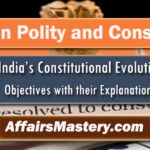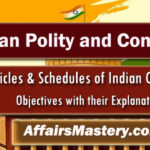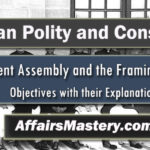Set 4 | Important Indian Constitution Evolution MCQs
Important Indian Constitution Evolution MCQs. The way the Indian Constitution has evolved over time plays a huge role in shaping Indian Polity and Governance, and it’s one of those things that really lays the groundwork for doing well in competitive exams—whether it’s Civil Services, State exams, SSC, Railways, Banking, or any of the others out there. Diving deep into Indian Polity, Constitution, and governance isn’t just about memorizing facts or ticking boxes for exams, but more about developing the kind of awareness that can make navigating these challenging exams a little less overwhelming and a lot more manageable.
| MCQs on Indian Constitution Evolution – Objective Questions and Answers |

Q31. Indian Constituent Assembly was established under – (Uttarakhand P.C.S. (Pre) 2012)
[A] Government of India Act, 1935
[B] Cripps Mission, 1942
[C] Cabinet Mission, 1946
[D] Indian Independence Act, 1947
View Explanation
Correct Answer is C.
- The Indian Constituent Assembly was formed based on the Cabinet Mission Plan of 1946, which proposed a framework for India’s political future and transfer of power from British rule.
- Elections for the Constituent Assembly were held in July 1946, and its first meeting was on 9th December 1946.
- Dr. Rajendra Prasad was later elected as the President of the Constituent Assembly, which eventually drafted the Constitution of India.
- [A] Government of India Act, 1935 → This Act laid the foundation for provincial autonomy and federal structure, but it did not propose a Constituent Assembly.
- [B] Cripps Mission, 1942 → It offered Dominion Status and self-rule to India but was rejected by Indian leaders as it lacked full independence provisions.
- [D] Indian Independence Act, 1947 → This Act granted independence to India and Pakistan but did not establish the Constituent Assembly, which was already formed in 1946.
Q32. In the Interim Government formed in 1946, the Vice- President of the Executive Council was. (I.A.S. (Pre) 1995)
[A] Jawaharlal Nehru
[B] Dr. S. Radhakrishnan
[C] C. Rajagopalachari
[D] Dr. Rajendra Prasad
View Explanation
Correct Answer is A.
- The Interim Government of India was formed on 2nd September 1946, based on the recommendations of the Cabinet Mission Plan.
- Jawaharlal Nehru was appointed as the Vice-President of the Executive Council, making him the de facto head of the Interim Government.
- The President (head) of the Executive Council was the Viceroy of India, Lord Wavell, but Nehru functioned as the head of the Council of Ministers, similar to a Prime Minister.
- [B] Dr. S. Radhakrishnan → He was not part of the Interim Government; he later became the Vice President of India (1952–1962) and President of India (1962–1967).
- [C] C. Rajagopalachari → He was not a member of the Interim Government, but later became the first Indian Governor-General (1948–1950).
- [D] Dr. Rajendra Prasad → He was part of the Interim Government as the Minister of Food and Agriculture, but he was not the Vice-President of the Executive Council.
Q33. Who of the following was not the member of the Interim National Government formed in August 1946 A.D.? (U.P.P.C.S. (Mains) 2010)
[A] C. Rajagopalachari
[B] Dr. Rajendra Prasad
[C] Dr. S. Radhakrishnan
[D] Jagjiwan Ram
View Explanation
Correct Answer is C.
The Interim Government of India (1946) was formed on 2nd September 1946 under the leadership of Jawaharlal Nehru as Vice-President of the Executive Council. It served as a transition government before India’s independence in 1947.
| S.No. | Member Name | Portfolio |
|---|---|---|
| 1 | Jawaharlal Nehru | Vice-President of Executive Council & External Affairs, Commonwealth Relations |
| 2 | Sardar Vallabhbhai Patel | Home, Information & Broadcasting |
| 3 | Dr. Rajendra Prasad | Food & Agriculture |
| 4 | Maulana Abul Kalam Azad | Education |
| 5 | Jagjivan Ram | Labour |
| 6 | Asaf Ali | Railways & Transport |
| 7 | C.H. Bhabha | Works, Mines & Power |
| 8 | Sarat Chandra Bose | Works, Mines & Power (Resigned later) |
| 9 | Syed Ali Zaheer | Posts & Air |
| 10 | John Mathai | Industry & Supplies |
| 11 | C. Rajagopalachari | (Not in Interim Government, but later became Governor-General) |
| 12 | Liaquat Ali Khan | Finance (Joined after Muslim League participation in October 1946) |
| 13 | I.I. Chundrigar | Commerce (Joined later from Muslim League) |
| 14 | Abdur Rab Nishtar | Posts & Air (Joined later from Muslim League) |
| 15 | Ghazanfar Ali Khan | Health (Joined later from Muslim League) |
Q34. Assertion (A) : According to the Wavell Plan, the number of Hindu and Muslim members in the Executive Council was to be equal. (I.A.S. (Pre) 2007)
Reason (R) : Wavell thought that this arrangement would have avoided the partition of India.
Code :
[A] Both (A )and (R) are individually true, and (R) is the correct explanation of (A).
[B] Both (A) and (R) are individually true, but (R )is not the correct explanation of( A).
[C] (A) is true, but (R) is false.
[D] (A) is false, but (R) is true.
View Explanation
Correct Answer is C.
- In October 1943, Lord Wavell became the Viceroy of India, taking over from Lord Linlithgow.
- Seeing the political deadlock, he tried to find a solution and later went to England in March 1945 for consultations with the British Government regarding Indian administration.
- After detailed discussions, he came up with certain proposals, which were made public in June 1945 and became known as the Wavell Plan.
Key Points Wavell Plan:
- Suggested restructuring the Governor-General’s Executive Council to ensure fair representation for all major communities.
- Equal representation for Hindus and Muslims in the Executive Council.
- All departments, including Foreign Affairs, were to be headed by Indians, except Defence, which would remain under British control.
- Apart from the Viceroy and the Commander-in-Chief, all members of the Executive Council would be Indians—a significant shift in governance.
Conclusion:
- The Wavell Plan aimed to address political and constitutional deadlock by promoting self-governance for Indians.
- However, it was never intended to bring Hindus and Muslims together to prevent India’s partition.
- That’s why the statement that the plan was meant to solve constitutional issues is true, but the claim that it was designed to unite Hindus and Muslims is false.
Q35. Who gave the idea of a Constituent Assembly firstly for the formation of Constitution for India? (I.A.S. (Pre) 1996)
[A] Swaraj party in 1934
[B] Congress party in 1936
[C] Muslim League in 1942
[D] All Parties conference in 1946
View Explanation
Correct Answer is A.
- The thought of setting up a Constituent Assembly to draft India’s Constitution was actually put forward for the first time back in 1934 by the Swaraj Party.
- It was an important step towards self-governance, as it meant that Indians would be responsible for creating their own laws instead of just following what the British imposed on them.
Q36. Which of the following statement(s) is/are true in relation to Constituent Assembly? (I.A.S. (Pre) 1993)
1. Assembly was based on adult suffrage.
2. The assembly was a result of direct election.
3. Assembly was a multiparty body.
4. Assembly worked through various committees.
Choose the correct answer by using the code given below:
Code:
[A] 1 and 2
[B] 2 and 3
[C] 3 and 4
[D] 1, 2, 3 and 4
View Explanation
Correct Answer is C.
- The Constituent Assembly of India wasn’t really formed through direct elections, and it also wasn’t based on adult suffrage. Instead, its members got elected indirectly by Provincial Legislative Assemblies under the Cabinet Mission Plan of 1946.
- But what’s important is that the assembly had multiple political parties involved in the process, and most of the work related to drafting the Constitution was done through various committees, each focusing on different aspects of governance and lawmaking.
Q37. Which of the following statements are correct regarding to Indian Constituent Assembly? (R.A.S/R.T.S (Pre) 2018)
A. It was not based on Adult Franchise.
B. It resulted from direct election.
C. It was not a multi-party body.
D. It worked through several committees.
Select the correct answer using code given below: Code :
[A] (A) and (D)
[B] (A) and (B)
[C] (B) and (C)
[D] (A), (B), (C) and (D)
View Explanation
Correct Answer is A.
- The Constituent Assembly of India wasn’t really formed through direct elections, and it also wasn’t based on adult suffrage. Instead, its members got elected indirectly by Provincial Legislative Assemblies under the Cabinet Mission Plan of 1946.
- But what’s important is that the assembly had multiple political parties involved in the process, and most of the work related to drafting the Constitution was done through various committees, each focusing on different aspects of governance and lawmaking.
Q38. Which one among the following is an incorrect statement about the Constituent Assembly? (M.P.P.C.S. (Pre) 2012)
[A] It worked with the help of a large number of committees, the most important among them being the Drafting Committee
[B] Minority communities like Christians, Anglo-Indians, and Parsis were adequately represented in the Assembly
[C] It was elected on the basis of universal adult franchise
[D] Its electoral process was based on the sixth schedule of the Act of 1935 which allowed for a restricted franchise based on tax, property and educational qualification
View Explanation
Correct Answer is C.
- The Constituent Assembly of India was not elected on the basis of universal adult franchise. Instead, its members were indirectly elected by the Provincial Legislative Assemblies as per the Cabinet Mission Plan of 1946.
- The process of electing representatives was restricted, as voting rights were based on tax, property, and educational qualifications, as outlined in the Government of India Act, 1935.
Q39. Member of constituent assembly, who drafted the Constitution of India, were- (I.A.S. (Pre) 2002)
[A] Nominated by British parliament
[B] Nominated by Governor General
[C] Elected by legislative assemblies of various provinces
[D] Elected by Indian National Congress and Muslim League
View Explanation
Correct Answer is C.
- The members of the Constituent Assembly, who were responsible for drafting the Constitution of India, were not directly elected by the people.
- Instead, they were indirectly elected by the Provincial Legislative Assemblies, which were formed based on the Government of India Act, 1935.
- These assemblies were primarily composed of representatives from the Indian National Congress and the Muslim League, but members from other communities and groups were also included.
Q40. With reference to Indian History, the Members of the Constituent Assembly from the Provinces were (I.A.S. (Pre) 2013)
[A] Directly elected by the people of those Provinces
[B] Nominated by the Indian National Congress and the Muslim League
[C] Elected by the Provincial Legislative Assemblies
[D] Selected by the government for their expertise in constitutional matters
View Explanation
Correct Answer is C.
- Back in 1946, when the Cabinet Mission put forward its recommendations, the way members of the Constituent Assembly got elected wasn’t just a random decision.
- It was actually done through the Provincial Legislative Assemblies, where the members of these assemblies were the ones responsible for choosing who would be part of the Constituent Assembly.
- This whole process wasn’t direct voting by the people but rather an election within those existing assemblies, making it a system where representatives selected other representatives to take on the crucial task of shaping the Constitution.
Related articles:
- Set 1 | Important Indian Constitution Evolution
- Set 2 | Important Indian Constitution Evolution
- Set 3 | Important Indian Constitution Evolution
- Set 5 | Important Indian Constitution Evolution
- Set 6 | Important Indian Constitution Evolution
- Set 7 | Important Indian Constitution Evolution
- Set 8 | Important Indian Constitution Evolution




